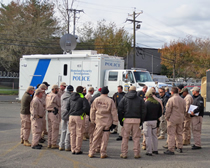TOP STORY: HSI RRTs deploy in Sandy's aftermath
In the wake of one of the worst storms to ever hit the northeastern seaboard, U.S. Immigration and Customs Enforcement's (ICE) Homeland Security Investigations (HSI) Rapid Response Teams have been doing their part to assist in Hurricane Sandy's aftermath.
As part of the massive recovery efforts, 40 members from the HSI Atlanta and HSI Tampa's Rapid Response Teams deployed to HSI Newark, where they responded to a local call for assistance to check on a pregnant, Hoboken, N.J., woman.
"Our team members are ready to go at a moment's notice," said Special Agent Shawn Meehan, program manager for ICE's Rapid Response Teams. "The teams not only provide disaster relief services to ICE employees and protect ICE facilities, they also assist with general law enforcement and respond to emergency calls like this one."
In addition to being ready to respond to local emergency calls, the Tampa, Atlanta, Newark, New York and Boston teams have been making sure that missing ICE employees are secure and accounted for. The Atlanta team was also responsible for ensuring perimeter security of its local HSI office building.
Members of these teams know there is still much work left to do; and nearly 105 members from the Boston, New York and Newark, Atlanta and Tampa teams are fully ready to deploy in and around their respective areas – helping with any and all recovery efforts.
ICE currently has 15 Rapid Response Teams; all of which are operational 24/7 and prepared to deploy to an affected area within 12 to 24 hours. The teams all share the same mission – to rapidly deploy during natural and manmade disasters, as well as emergency situations, when other federal, state or local government agencies request ICE assistance. Their training includes a weeklong program where they receive instruction on disaster response and deploy to the field as they would for a real disaster response scenario. Throughout the training, members are exposed to a variety of adverse conditions that are designed to promote team building and reinforce the need for the team to function as a cohesive unit.
"I'm glad we were able to respond in a fast and efficient manner," said Meehan. "That's what we train for. That's what our end goal always is."






